When I first started to quilt, I didn’t know the first thing about batting. I thought it came in bags and was made from polyester. How wrong could I be? It turns out there’s more to batting than I first thought. There are so many different options. Choosing the right batting is key to a successful quilting project. But what is batting fabric?
Batting fabric is the spongy, fluffy, insulating layer found inside quilts. Originally called wadding, batting can be made from polyester, cotton, wool, and bamboo. It comes in a range of thicknesses suitable for several projects. Items made with an inner layer of batting include pot holders, bowl cozies, and quilted throws.
In this article, we’ll take a look at the different types of batting available and which one you should be using for your next project.
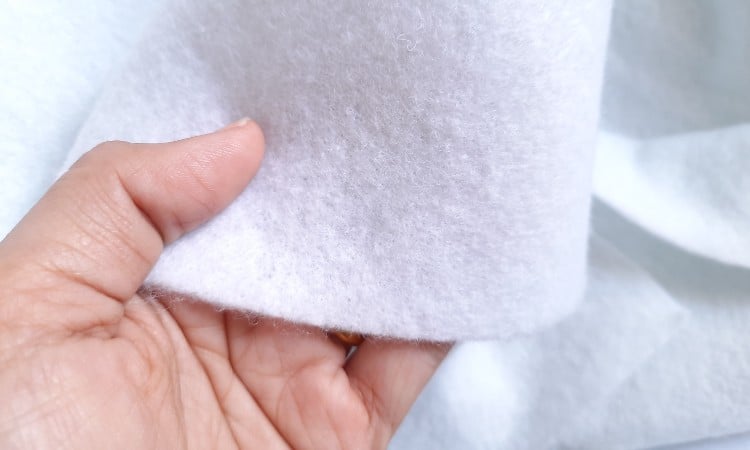
Quick Navigation
What Is Batting Fabric?
Batting fabric is the fluffy filling layer that forms the inner part of a quilt sandwich. It can be made from many fibers, including cotton, wool, and polyester. Whatever it’s made from, it performs the same role. Adding warmth and comfort to quilts and insulation properties to things like potholders and placemats.
These days you can buy batting in pre-cut sizes wrapped neatly in cellophane bags. There’s a size available to suit most quilts. You can even buy batting off the bolt or roll. In this case, it would be sold by the yard and ideal for custom-sized quilts. But it hasn’t always been that way. You see, ready-made batting is a relatively new invention.
Quilts, on the other hand, have been around since at least the 12th Century, maybe even earlier. Originally, they would have been stuffed with whatever the maker had to hand, from animal hair, human hair, feathers, clothing scraps, old blankets, and even straw.
All of these items had one thing in common. Because they were all individual pieces rather than one large flat piece of fabric, they tended to move. Bits would clump together to create little heaps of stuffing known as wads.
This irritating drawback to the quilts of yesteryear gave quilt stuffing its original name. Traditionally it was called “wadding”. Some parts of the world, such as the UK and Australia, still use the term wadding when referring to quilt stuffing.
If we jump forward to the United States in the 1800s, there’s a change to the fiber content of quilts. You start to see wool and cotton becoming the go-to choice for stuffing. These fibers would be carded into small lumps called batts.
In a similar way to wadding, the process of making the little batts became known as batting. This probably explains why wadding is called batting in the USA.
Regardless of the terminology, both wadding and batting needed to be kept stationary inside the quilt. No one likes a lumpy bedspread, not even back in the 1800s!
The quilt would have been heavily stitched by hand to stop the filling from bunching up. As time went on, this stitching became more and more decorative. Not only did it keep the wadding or batting in check, but it was also a showcase for fine needlework.
These days, modern batting is a single sheet of fibers woven into a fabric. This means there is less need for as much stitching to keep the fabric in check. Quilters still take the time to stitch decorative designs either by hand or machine.
Not only does it allow for two sheets of batting to be stitched together to use up scraps, but it also adds a personal touch to the quilt. In so doing, it keeps old quilting traditions alive.
Why Is Batting Fabric Sold by Loft?
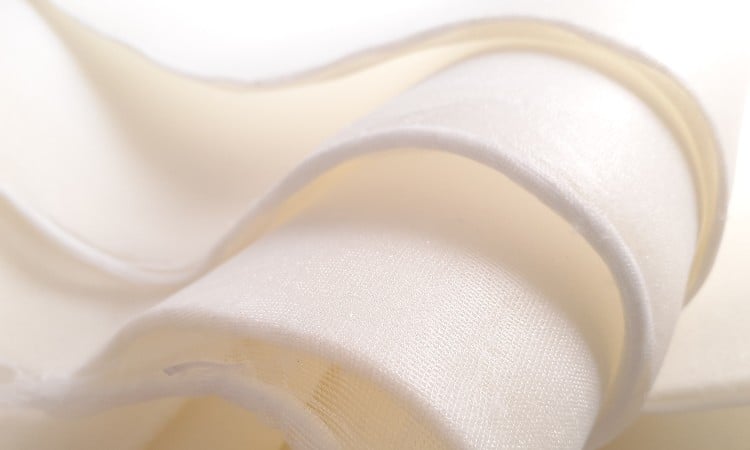
The term loft is used to identify the height of the fibers within the batting. The height, or loft, of the batting fabric indicates whether your quilt will be thick and fluffy or thin and flat.
There are two types of loft you should be looking out for. Low loft and high loft. Each one will give your quilt a different feel and texture. Let’s take a look at them in detail.
Low Loft
A low loft batting has short fibers. It’s a lightweight and tightly woven batting with little fluff. Low loft batting is thin, solid, and flat. You’d use this one for projects you want to be functional rather than warm and cozy.
Although this type of batting can be quilted with decorative stitches, you won’t get the same dimensional effect as you would with a high loft. As there isn’t any height to the loft, the stitches will be the same level as the batting. They won’t stand out or create pronounced ridges.
This loft is ideal for things that need to be flat, like wall hangings and table runners. Insulating batting used for potholders, placemats, and even bowl cozies is normally a low loft batting.
High Loft
High loft batting has height to the fibers. This gives it a thicker appearance than a low loft. It’s also fluffy to the touch and less tightly woven. With a drapey, looser feel, this loft is perfect for quilted throws and comforters.
As the loft is thicker, when you quilt it, the stitches have to go deeper into the quilt sandwich. You get more definition to the decorative designs as the stitching pulls the batting down. Your quilt top will pop and the effect will make your stitching stand out.
You can also get an extra high loft. As the name suggests, it’s a high loft batting, but on steroids. It has more height in the fibers and therefore is thicker, fluffier, and warmer. You’d use this loft for an extra cozy winter quilt.
One thing to be aware of, batting can also be sold by weight, particularly in areas where it’s known as wadding. In this instance, it’s sold by the ounce. The smaller the ounce amount, the more lightweight and thin the batting will be.
Popular ounce weights are 4oz, usually 3/8 -inch thick, 8oz normally ¾ inch thick, and 10oz at 1 inch thick. To put this in perspective, the 10oz wadding would be equivalent to a high loft batting.
Different Types of Batting Fabric
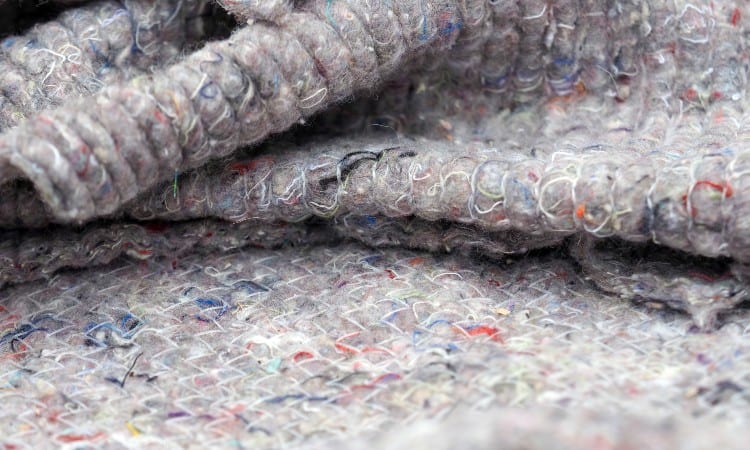
Batting comes in a range of options. Each has different properties and strengths, meaning there is a batting available to suit you and your latest project. The one you choose is down to the type of quilt you are working on.
Let’s take a look at some of the more popular types of batting. Hopefully, seeing them side-by-side will help you decide which one is better suited to the project you have in mind.
1. Natural Batting
 This batting is made with fibers from natural products like wool and cotton. It can also be made from rayon or bamboo. Although rare due to the expense, you can sometimes see silk fibers in a natural batting.
This batting is made with fibers from natural products like wool and cotton. It can also be made from rayon or bamboo. Although rare due to the expense, you can sometimes see silk fibers in a natural batting.
Wool is the most popular of natural battings as it tends to shrink less and gives an unbeatable warmth. It’s also really easy to work with. You can hand quilt it, machine quilt it. Or, if you don’t fancy stitching your quilt, you can tie it.
Coming in a close second in the popularity stakes is cotton batting. With incredible breathability and a super cozy feel, cotton makes a great batting for baby quilts.
Natural battings have a more traditional feel than synthetic ones and are often used to produce heirloom quilts. They are particularly popular for quilters who use historically accurate practices to construct their quilt sandwiches.
Unfortunately, as with most natural fabrics, natural batting can be expensive. Especially when compared to a polyester one. The good news, the quality of the product combined with the unbeatable benefits of a natural fiber more than make up for the extra expense.
2. Synthetic Batting
 Synthetic or manmade batting is usually made from polyester fibers. A particular favorite polyester batting is the super warm and cozy fleece version.
Synthetic or manmade batting is usually made from polyester fibers. A particular favorite polyester batting is the super warm and cozy fleece version.
Due to being cheap and readily available, polyester battings are the everyday answer to quilt stuffing. They can be used in any quilting project and come in either low or high loft. Better still, the batting will be a lot lighter than a natural batting of the same loft. This means you can have a super fluffy quilt without feeling weighed down.
There is a little bit of a downside though. As synthetics like polyester don’t breathe, quilts made with them as an inner layer won’t breathe that well either. Not a problem for king-size quilts or lap quilts. But, it could be an issue for baby quilts or cot quilts.
Babies can’t regulate their temperature, so it’s best to avoid polyester batting. They need bedding made from materials that can help them warm up or cool down.
3. Polycotton Batting
 A polycotton batting will give you the best of both worlds. This means you get the breathability of cotton coupled with the shrink resistance and durability of a synthetic. Normally, the blend is an 80/20 cotton/polyester mix. In fact, rather than being called polycotton batting, this one is usually referred to as 80/20 batting.
A polycotton batting will give you the best of both worlds. This means you get the breathability of cotton coupled with the shrink resistance and durability of a synthetic. Normally, the blend is an 80/20 cotton/polyester mix. In fact, rather than being called polycotton batting, this one is usually referred to as 80/20 batting.
Another great thing about this batting, it tends to have a higher loft than 100% cotton batting does. It also tends to be lighter thanks to the polyester content and won’t shrink quite as much.
That’s not all; due to the high cotton content, it makes an excellent alternative to 100% synthetic batting. It is an all-around batting that ticks the boxes for hand and machine quilters alike.
4. Bamboo Batting
 Bamboo batting is an equal 50/50 mix of cotton and bamboo fibers. As bamboo is more sustainable than cotton, this batting is considered the best ecological option. Its natural fiber content provides anti-bacterial properties and a high level of breathability.
Bamboo batting is an equal 50/50 mix of cotton and bamboo fibers. As bamboo is more sustainable than cotton, this batting is considered the best ecological option. Its natural fiber content provides anti-bacterial properties and a high level of breathability.
A bamboo batting tends to shrink less than a batting completely made from cotton. Apart from that, it’s not that easy to tell the difference between cotton and bamboo, especially if you go for a top brand. Better still, you’ll get the same loft choices and the same super soft feel.
Not only is bamboo batting machine washable, but you can also dry it in a dryer. This makes it an easy-care option for items that need constant washing, like baby quilts.
There is a slight disadvantage with bamboo batting, though. Due to the fiber content, it can be more expensive than a 100% cotton version. However, the extra cost is worth it when considering the many benefits of choosing bamboo.
5. Bonded Batting
 Bonded batting is a batting fabric that has a coating of adhesive on the top and bottom surfaces. This adhesive can be either a resin or glue. You can also find thermally-bonded batting. All the bonded options hold the fibers of the batting together.
Bonded batting is a batting fabric that has a coating of adhesive on the top and bottom surfaces. This adhesive can be either a resin or glue. You can also find thermally-bonded batting. All the bonded options hold the fibers of the batting together.
The reason why it’s good to have bonded batting is simple. It stops the fibers from the batting poking through the quilt top or backing. Known as bearding, this is where you see small flecks of white fibers all over the top of your quilt. It’s the same kind of effect as duck down poking through an old eiderdown.
Resistance to bearding makes this batting a good choice for projects using thinner fabric on the outside of a quilt sandwich. You can also use it for items that don’t necessarily need a lot of decorative stitching. The bonded surface means it doesn’t need to be stitched to keep it from bunching.
6. Needle-Punched Batting
 This is another method manufacturers use to produce bearding-free batting. Only instead of adhesive, this option uses needles.
This is another method manufacturers use to produce bearding-free batting. Only instead of adhesive, this option uses needles.
To make needle-punched batting, the fibers are hit with lots of needles. In a process called felting, the needles punch the fibers together to make a solid surface. Thus creating a firm batting with a dense feel.
A needle punched batting works well for quilted apparel and blankets. You can even use it for a quilt backing. With a similar appearance to felt fabric, it’s both strong and durable.
7. Fusible Batting
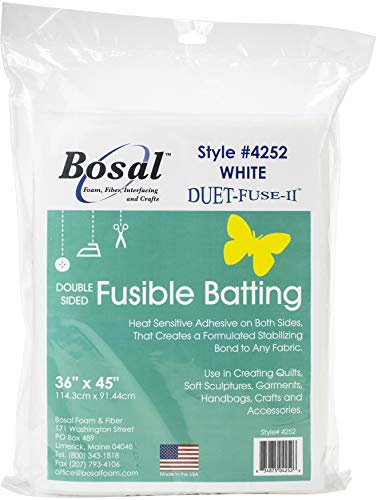 Fusible batting is a labor-saving device. Instead of holding your quilt sandwich together with loads of safety pins, you can iron your quilt top and backing to the batting.
Fusible batting is a labor-saving device. Instead of holding your quilt sandwich together with loads of safety pins, you can iron your quilt top and backing to the batting.
Not only does it save time, but it also takes away the hassle of bending over a quilt sandwich trying to push your safety pins through all three layers. Even better, fusible batting is better at keeping the three layers still while you stitch your designs on your quilt.
The product contains a fusible web that can be ironed on both sides. For best results, you should allow one side to cool before ironing the other.
8. Insulated Batting
 Insulated batting is a specialty batting designed for use in items that protect against heat damage. You can use this batting in potholders, oven mitts, and bowl holders. It’s also good for adding extra insulation to tea cozies and table runners.
Insulated batting is a specialty batting designed for use in items that protect against heat damage. You can use this batting in potholders, oven mitts, and bowl holders. It’s also good for adding extra insulation to tea cozies and table runners.
This batting has a crinkle sound as you work with it and is fairly stiff. When you look at it, you can see tiny silver flecks throughout the batting.
A word of caution with insulated batting, some brands contain polyester. Combined with the silver bits, it’s not a good idea to put anything made using a polyester batting in the microwave. That includes bowl cozies! The polyester content will melt and the silver parts will cause sparks.
There are insulated battings that can be heated in a microwave. If you want to be able to do that, make sure your batting is 100% cotton. You’ll also need to have cotton thread and fabric too!
How to Use Batting Fabric
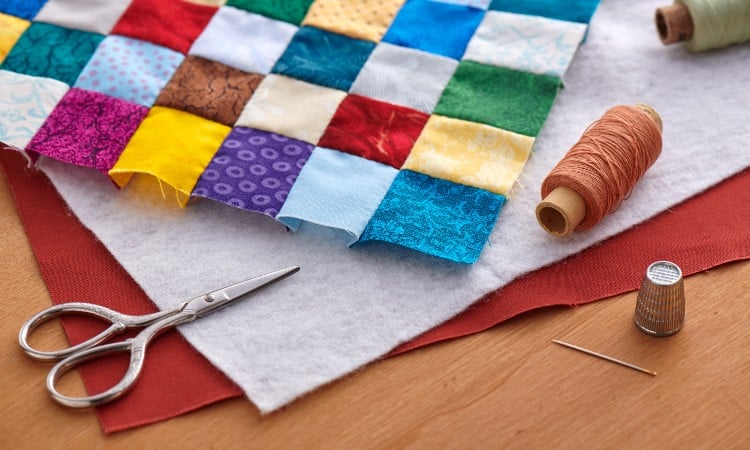
As mentioned before, batting is the inner layer of a quilt sandwich. There are usually three layers to a quilt. The top layer is the decorative side, with either a patchwork or block design. Then you have the bottom layer, which is usually a plain backing fabric. In the middle, you have the batting.
In this section, I’ll walk you through the different steps for making a quilt sandwich. The kind of batting you use is up to you. Both these methods will work equally well with any of them.
Although you may find it easier to machine quilt battings containing fusible web or adhesive, it’s not impossible to hand quilt them. It just might take a bit longer than usual.
A quick note, if you are using needle-punched batting, you can reduce your quilt sandwich to two layers if you like. Needle Punched batting is solid enough to play the role of padding and backing.
Preparing your fabric for quilting is the same regardless of the method you choose. The supplies you need are also very similar. Let’s take a look at those first.
You will need:
- Quilt top and backing fabric
- Batting
- Hand quilting needle
- Hand quilting thread
- Sewing machine
- Sewing machine thread
- Safety pins
Quilt Preparation: Hand or Machine Quilting
Step 1
Make sure both your quilt top and backing fabric are free from creases. Give them a quick iron. For best results, make sure any seams on your quilt top are pressed towards darker colors. This will stop them from showing through on the right side.
Step 2
Put your backing fabric face down on a flat surface and smooth it out without ripples. Next, put your batting on top of it. Lastly, lay your quilt top face up on top of the batting. This is your quilt sandwich. Make sure you smooth out the quilt top too.
Step 3
Using your safety pins, start in the center of the quilt sandwich and start to pin the three layers together. Pins should be about 4 inches apart. Work from the center, smoothing the fabric as you go. Any ripples should be pushed out towards the edges.
Step 4
If you find your fabric is uneven once you have pinned it, leave it. You might need the extra as you quilt. The reason is the quilting stitches will pull the fabric inwards. So don’t trim anything until after you finish quilting.
Once you have completely pinned your quilt together, you are ready to quilt. Choose one of these next methods.
Hand Quilting
Hand quilting is the traditional method for constructing a quilt sandwich. Although you can use any batting you like for this one, consider using an all-natural batting for a traditional feel. Wool or cotton are ideal.
Step 1
Load up your hand quilting needle with your hand quilting thread. Both of these are specifically designed for quilting. Although you can use other thread and needles, you’ll find it will make the quilting process harder.
Step 2
Using either a running stitch or backstitch, start to hand stitch the quilt together. Begin in the middle of the quilt and work outwards so you can smooth out ripples as you work. Go through the top, straight through the batting, and out through the backing with each stitch. You can follow the seam lines on the quilt top or work in a decorative design of swirls, leaves, or even feathers. It’s up to you.
Step 3
When you have finished sewing the batting fabric to the quilt top and bottom, trim off any excess fabric and bind your quilt.
Machine Quilting
This is the more modern approach to quilting. It gives a similar effect but in a far quicker way. Whether you choose to hand quilt or machine quilt is up to you and your lifestyle. Neither option is better than the other. It’s down to personal preference.
Step 1
Thread your sewing machine and bobbin with machine quilting thread. You can use an all-purpose thread for this, but a specific quilting thread will be stronger.
Step 2
Decide whether you want to stitch in the ditch or free motion quilt. Stitching in the ditch is where you follow the seams on the quilt top by stitching in the ditch formed by the previous stitching. This will give you straight lines along the top of your quilt. For best results, start sewing from the middle of the quilt and then work outwards. Starting at the center allows you to push out any ripples, bumps, or ridges in the batting fabric as you work.
For free-motion quilting, you’ll need to drop your feed dogs or cover them, so they don’t touch the fabric. Move your quilt sandwich until the center of the quilt is under the presser foot. Then, simply move your quilt in swirls to create a free motion design. It’s a bit like doodling only on your sewing machine.
Step 3
Once you have completed the stitching, trim off any excess fabric. Finally, bind your quilt and your batting fabric will be secured.
Batting vs Interfacing: What’s the Difference?
Although they sound like similar products, batting fabric and interfacing are very different. They both perform specific tasks.
Interfacing is used to reinforce areas of a garment. You would use it to strengthen button plackets or make collar stands rigid enough to stand up. Jacket lapels and cuffs also need interfacing to keep them stable and solid. Using interfacing gives structure and form to fabric.
Batting, on the other hand, is designed to add warmth and padding to utility items like quilts. It can offer heat protection in potholders. As well as keeping your tea warm when used in a tea cozy. Although batting fabric can be used in garments, it doesn’t provide structure. Nor can it be used to keep a button placket from tearing.
The two products are not interchangeable. Interfacing can’t provide padding or warmth. Batting in your collar stand will be uncomfortable against your neck and incredibly floppy.
Can I Use Insulbrite Instead of Batting?
Insulbrite is a brand name for insulated batting. It was invented by the Warm Company and is used in products offering protection from heat.
It’s a specially designed fabric that reflects heat onto itself, so your hands don’t get burned when you take food out of the oven. Or to keep your soup warm when the bowl is wrapped in a bowl cozy.
You wouldn’t normally use it instead of batting. It’s not meant for padding in a bed quilt or anything like that. Nor would you use it on its own in a potholder. Normally you would use Insulbrite as well as ordinary batting.
Potholders, bowl cozies, and placemats are usually made with one layer of Insulbrite and another layer of an ordinary batting fabric. Ordinary batting will suck up some of the reflected heat, so it takes longer to reach your hands. You would then quilt both battings into a quilt sandwich like any other type of quilt.
Is Batting the Same as Toy Stuffing?
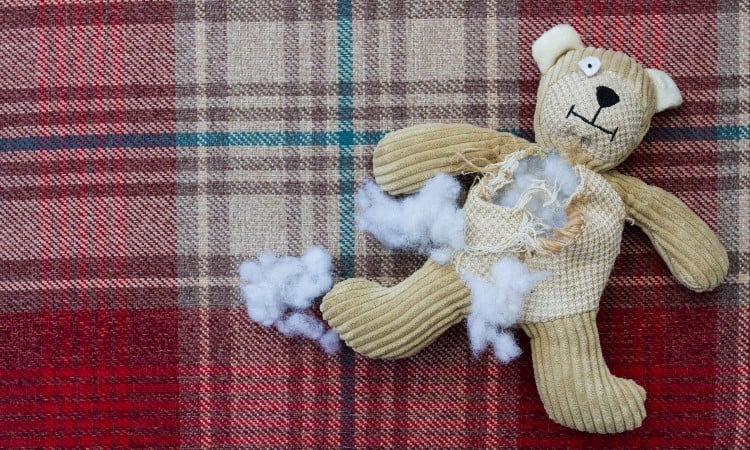
Batting and toy stuffing are fairly similar in that they are both types of stuffing. There is a difference between the two though.
Toy Stuffing is sold in bags as loose fibers that can be pulled apart into hand-sized balls or clumps. It’s easier to stuff toys with smaller pieces as you can mold them into the shape of the toy as you go. The toy stuffing comes apart easily and you can use as much or as little as you like.
Batting comes in flat sheets by the yard or rolled up in bags. The key difference here, it’s formed into fabric in both the bag and yardage options. It’s either bonded or needle punched together to create a flat piece of fabric and doesn’t pull apart easily. To get a different size in a batting fabric, you would normally cut bits off.
Although it isn’t impossible to use batting fabric as toy stuffing, it isn’t ideal. The toy would be stiff and misshapen as batting fabric doesn’t mold to shapes that well.
It would be a real pain to try to use toy stuffing as the inner fabric of a quilt. As it’s loose fiber rather than a fabric, it would take ages to lay it out across your backing material. You would also need lots of it to make an even filling across the whole quilt.
Keeping it from bunching up into wads would be tricky too. It would be like stepping back in time to use the original wadding or batting fabrics of old.
Conclusion
Batting fabric is the essential padding layer found inside quilted items. It provides warmth, insulation, and comfort. Making it a handy material for crafts, quilts, and garments.
I hope you liked today’s article. If you did, let me know in the comments. Have you ever used batting? Do you call it wadding? Which sort did you use and how did your project turn out?